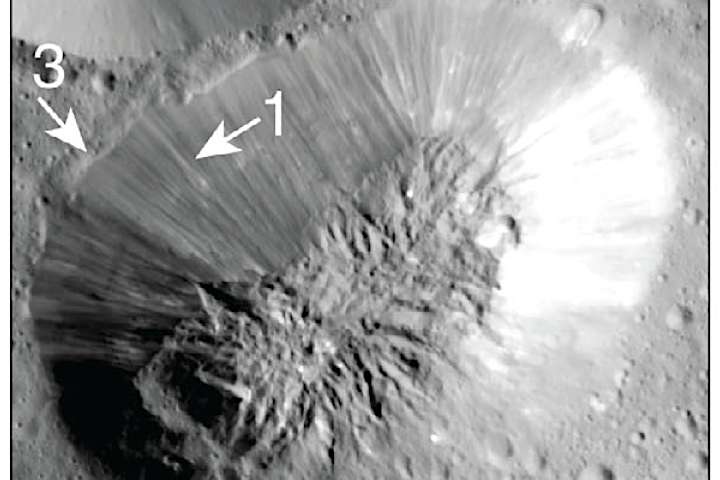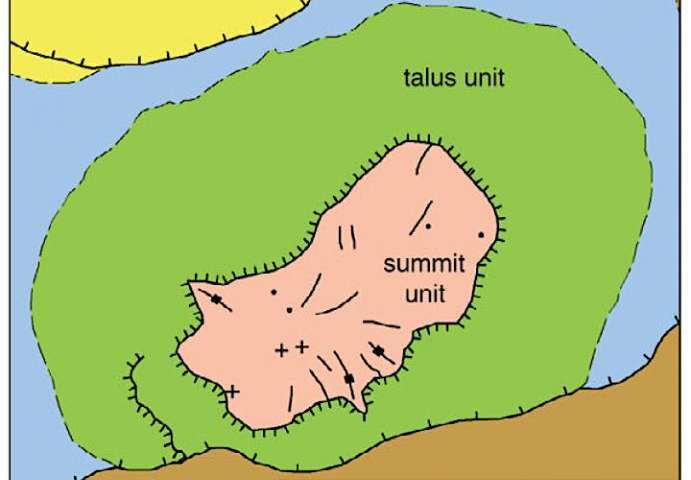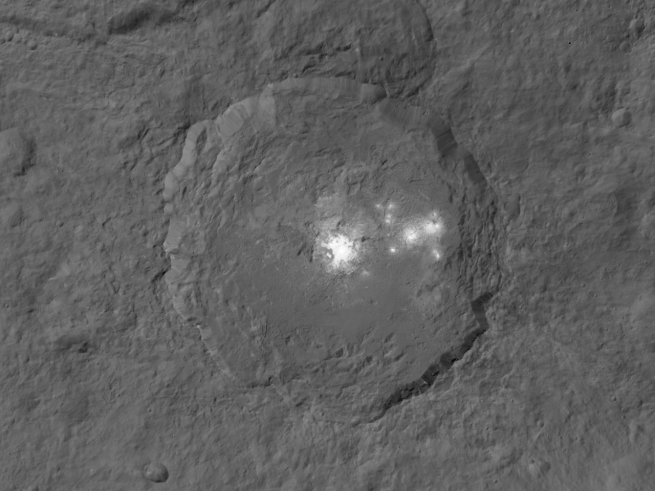The existence of cryovolcanoes in Ceres is confirmed

Ahuna Mons, powerful cryovolcan in Ceres
Ahuna Mons is a mountain with a height of 4 kilometers and a base diameter of 17 kilometers. It would look impressive even on Earth. But Ahuna Mons is not located on Earth, but on Ceres, the dwarf planet that the Dawn probe recently visited. The diameter of the planet is only 950 kilometers, so it is simply impossible not to notice a mountain of this size on the surface of a planetoid.
“Ahuna is the only real mountain in Ceres,” says David Williams, a member of a team of specialists researching materials transmitted by the Dawn probe. Williams is sure that Ahuna Mons is not just a mountain, but a cryovolcan. There are no ordinary volcanoes in Ceres with their lava, smoke and volcanic bombs. Ahuna Mons throws to the surface not lava, but water with dissolved ammonia and other chemical compounds. According to experts, Kriovulcan erupted several times during its existence.
')
Williams and his colleagues this week published the results of their research in the journal Science. “Akhuna is a unique mountain,” scientists write. “There are no signs of tectonic activity on Ceres, so we came to the conclusion that this mountain is, in fact, a cryovolcan.” Researchers believe that this is the only cryovolcano known to science, which, presumably, was formed from water mixed with salts, and appeared, by geological standards, relatively recently.

The age of this cryovolcano is about 200 million years. Such a conclusion, scientists have made, examining the surface of the mountain. There are only a few craters.
The surface temperature of Ceres is -40 ° C. At the same time the insides of the mountain remain warm enough for the existence of water in liquid form, and not in the form of ice. Sometimes the water goes outside where it freezes. Now, as far as can be judged, this volcano is inactive.
Ahuna Mons is not the only place in Ceres where cryovolcanism is observed. The instruments of the Dawn probe have recorded cryovolcanic activity in other regions of the dwarf planet. True, this is not about the mountains, similar to that described above. A series of craters formed during the impact of meteorites on the surface of the planet. At the same time, these craters are flat, which may indicate that the crater was filled with liquid water after a meteorite impact. This phenomenon can be described as water lava, which, after filling the crater, freezes.
The Occator crater, where high albedo spots are located, also became an object of study for Williams and colleagues. In their opinion, the spots are similar to the effects of cryovolcano. Water that comes out and freezes appears to contain sodium carbonate. Other bright spots have the same origin. And in some cases, the water evaporates, and the salts remain.

Geological map of Akhuna Mons (source: Dawn Science Team and NASA / JPL-Caltech / GSFC)
Scientists study not only objects on the surface of Ceres. They try to understand the structure of the dwarf planet. Williams believes that the inner layers of Ceres are not rock or ice, but both. Most likely, he says, the bark of Ceres and the underlying layer are 30–40% ice, 60–70% rocks and various chemical compounds.
The fact that there is water on Ceres, in liquid form and in the form of ice, is considered proven . The first opinion was that the scientist Ottaviano Ruesch expressed the opinion that Ahuna Mons is a cryovolcan. His words were confirmed by another scientist, Jean-Philippe Combe, who studied the cryovolcano structure and the Dawn probe data series. The results of the third study were presented by Christopher Russell [Christopher Russell], lead specialist of the Dawn probe team. He and his colleagues discovered that Ceres somehow reflects the particles of high energy from the solar wind. According to this team of scientists, the presence of a large amount of salts on the surface of the planetoid is the cause of the generation of electric current. The current, in turn, generates a magnetic field, which reflects the particles.

A fourth study by Harald Hiesinger showed that there is ice on the surface of Ceres. This was discovered using the Dawn probe's Framing Camera (FC) tool. The results of the fifth study conducted by Debra Buczkowski demonstrated the presence of a large number of different formations on the surface of Ceres (craters, linear structures, elevations). Some objects of this kind appeared as a result of meteorite strikes on the surface of Ceres. But others could only arise as a result of geological activity on the planetoid. Finally, the results of the sixth study conducted by Eleonora Ammannito and her colleagues showed the presence of phyllosilicate minerals on Ceres. And they could be formed only in the presence of water.
Ceres is the closest to the Sun and the smallest among the known dwarf planets of the Solar System. It is located, like a number of other planetoids, in the asteroid belt. Ceres was discovered on January 1, 1801 by the Italian astronomer Giuseppe Piazzi at the Palermo Astronomical Observatory. For some time, Ceres was regarded as a full-fledged planet of the solar system. According to the results of the clarification of the concept “planet” by the International Astronomical Union on August 24, 2006 at the XXVI General Assembly of the IAS, it was referred to as dwarf planets. She was named after the ancient Roman fertility goddess Ceres.
Source: https://habr.com/ru/post/397311/
All Articles